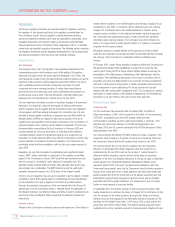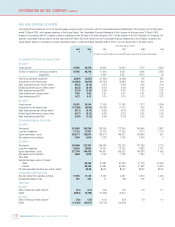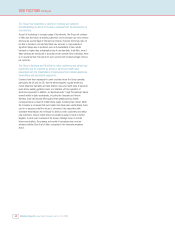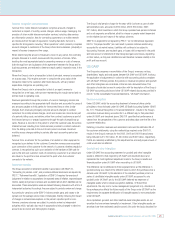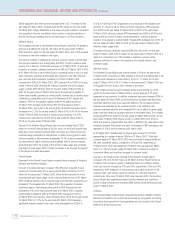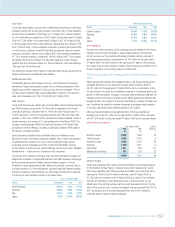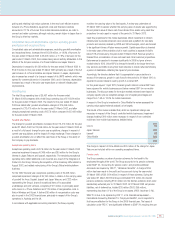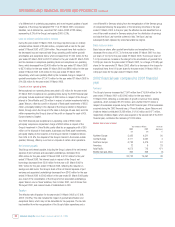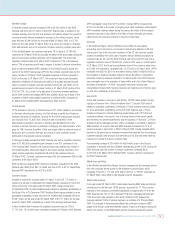Vodafone 2003 Annual Report Download - page 30
Download and view the complete annual report
Please find page 30 of the 2003 Vodafone annual report below. You can navigate through the pages in the report by either clicking on the pages listed below, or by using the keyword search tool below to find specific information within the annual report.
Vodafone Group Plc Annual Report & Accounts and Form 20-F 2003
28
OPERATING AND FINANCIAL REVIEW AND PROSPECTS Continued
Goodwill, including associated charges for amortisation, affects all of the Group’s
reported segments. However, given that the majority of the current goodwill asset
arose in connection with the Mannesmann acquisition, the Group’s results for
Central Europe and Southern Europe are most affected, representing £6,643
million and £4,334 million, respectively, of the £14,056 million total charge for
goodwill amortisation.
The charge for goodwill amortisation is included within operating profit as a
separate category of administrative expenses. However, goodwill amortisation
represents a non-cash charge and therefore does not affect the Group’s cash
flows and ability to pay dividends.
Other intangible assets
Other intangible assets represent the Group’s aggregate amounts spent on the
acquisition of 2G and 3G licences, stated after deduction of related amortisation
charges.
Amortisation of capitalised licences begins either when the related network
commences commercial service, or earlier under certain circumstances. As
networks are typically brought into service over a period of time, the charge for
amortisation is initially calculated by reference to the capacity of the network
compared to capacity at network maturity. For this purpose, network maturity is
reached after a maximum period of five years from service launch. Thereafter,
amortisation is on a straight line basis over the period remaining until the licence
expires.
Tangible fixed assets
Tangible fixed assets are included on the Group’s balance sheet at cost and
stated after accumulated depreciation charges. Cost includes the total purchase
price and labour costs associated with the Group’s own employees to the extent
that they are directly attributable to construction costs, or where they comprise a
proportion of a department directly engaged in the purchase or installation of a
fixed asset. Management judgement is involved in determining the appropriate
internal costs to capitalise and the amounts involved. As at 31 March 2003,
internal costs capitalised represented approximately 4% of expenditure on
tangible fixed assets in the year and less than 4% of total operating expenses,
excluding goodwill amortisation.
Finance costs are not capitalised under the Group’s UK GAAP accounting
policies but, under US GAAP, the interest cost on borrowings used to finance the
construction of network assets is capitalised during the period of construction
until the date the asset is placed in service. Interest costs on borrowings to
finance the acquisition of the related cellular licences necessary to operate the
network are also capitalised until the date the network is commercially
launched.
Once capitalised, tangible assets are subject to periodic depreciation which also
requires management judgement.
The charge in respect of periodic depreciation, which is reported either as part of
cost of sales or administrative expenses, depending on the nature of the
underlying fixed asset, is derived after determining an estimate of an asset’s
expected useful life and the expected residual value at the end of its life. Results
for all segments include charges for depreciation. Increasing an asset’s expected
life or its residual value would result in a reduced depreciation charge in the
Group’s profit and loss account.
The useful economic lives of Group assets are determined by management and
regularly reviewed for appropriateness. However, asset lives are often also
subject to other criteria, for example network infrastructure cannot be
depreciated over a period that extends beyond the expiry of the associated
licence under which the operator provides telecommunications services.
Impairment
Asset recoverability is also an area involving management judgement, requiring
assessment as to whether the carrying value of assets can be supported by the
net present value of future cash flows derived from such assets using cash flow
projections which have been discounted at an appropriate rate. In calculating the
net present value of future cash flows, certain assumptions are required to be
made in respect of highly uncertain matters, for example: expected cash flows
from the Group’s businesses; management’s expectations for growth in
revenues, including those relating to achievement of the Group’s strategy on data
products and services; timing and quantum of future capital expenditures; and
uncertainty of future technological developments, all of which are discounted at a
rate to reflect the risks involved.
UK GAAP, in the form of FRS 11, “Impairment of fixed assets and goodwill”,
requires management to undertake regular reviews of the carrying value of its fixed
assets, including goodwill. Group management currently undertakes a review of its
goodwill and intangible assets at least annually, during which the assumptions
underpinning the valuations are subject to detailed review and challenge.
Changing the assumptions selected by management to determine the level if any
of impairment including, in particular, the discount rates or growth rate
assumptions used in the cash flow projections, could significantly affect the
Group’s results. In discussing the results of the Group’s review of the carrying
value of its fixed assets with the Audit Committee, particular focus is given to
those material assets where growth rates used are in excess of expected
relevant country growth in nominal GDP in the short term.
The Group has undertaken a review at 31 March 2003 which assessed whether
the carrying value of its assets could be supported by the net present value of
future cash flows derived from assets using cash flow projections for each asset in
respect of the period to 31 March 2013. The results of the review indicated that,
whilst no impairment charge was necessary in respect of the Group‘s controlled
mobile businesses, impairment charges totalling £810 million were necessary in
respect of non-controlled mobile and non-mobile businesses. For further details of
the results of this impairment review, see “Operating Results – 2003 financial year
compared to 2002 financial year – Exceptional operating items”below, and note
14 to the Consolidated Financial Statements, “Impairment”.
Taxation
The Group’s tax charge on ordinary activities is the sum of the total current and
deferred tax charges. The calculation of the Group’s total tax charge necessarily
involves a degree of estimation and judgement in respect of certain items whose
tax treatment cannot be finally determined until a formal resolution has been
reached with the relevant tax authority or, as appropriate, through a formal legal
process.
The growth in complexity of the Group’s structure following its rapid expansion
geographically over the past few years has made the degree of estimation and
judgement more challenging. The resolution of issues is not always within the
control of the Group and it is often dependent on the efficiency of the legal
processes in the relevant taxing jurisdictions in which the Group operates. Issues
can, and therefore often do, take many years to resolve. Payments in respect of
tax liabilities for an accounting period result from payments on account and on
the final resolution of open items. As a result there can be substantial differences
between the tax charge in the profit and loss account and tax payments.
Under UK GAAP, FRS 19, “Deferred tax”, permits a choice of calculating deferred
taxation assets or liabilities on a discounted or undiscounted basis. It is the
Group’s accounting policy to measure deferred taxation on an undiscounted
basis. If deferred taxation liabilities were calculated using discounting techniques,
the Group’s net deferred taxation liability would be lower.


